Mokruha mushroom: description of species, places of collection and cooking features
Mokruhi - ediblebelonging to two genera: chroogomphus and gomphidius. The name of these forest gifts is associated with a specific appearance, because slippery mushroom caps are covered with a layer of mucus.
Botanical description of mokruhi mushroom
Mokruhi (Gomphídius) are large mushrooms, which can be more than 10 cm high, their hat reaches the same size. Depending on the species, in young specimens they are convex or conical in shape. And in the "old men" they are even with a slightly concave center.
The flesh of different representatives of mokruh differs in color diversity. It can be white-gray, bright orange, brown or pink-white, turning pink or red at the break.
The legs of the mushrooms are massive, thickened at the bottom, they are light cream and, like the caps, are slimy. On top of them there is also a ring of mucus. Firm flesh changes color from yellow (bottom) to off-white (top).
Appearing in the middle of summer, these mushrooms bear fruit almost until frost. There are single specimens, but more often these gifts of the forest grow in small families.
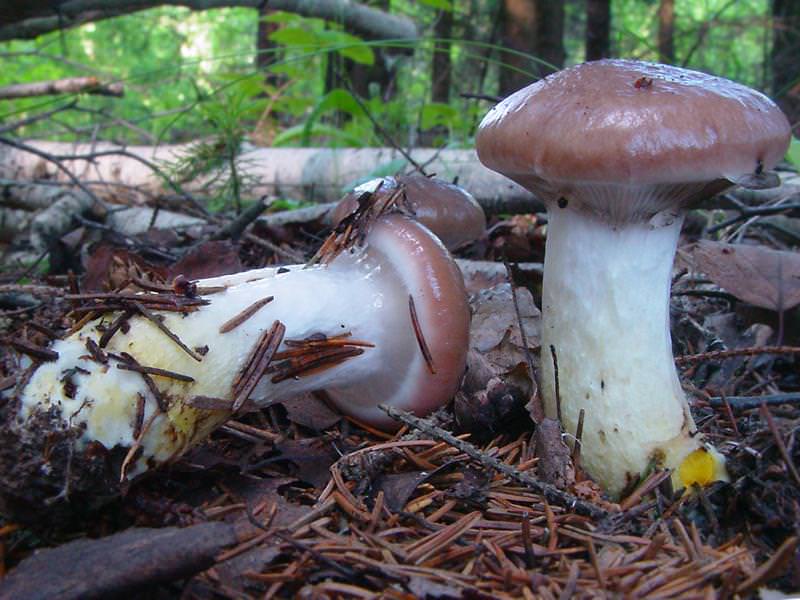
Places of growth of mokruh
Mokruhi is far from uncommon in coniferous or mixed forests. They can be found in moss under pines, spruces or firs. The mass collection of mushrooms, which beginner mushroom pickers bypass, but are appreciated by experienced ones, falls on the horses of summer and early autumn.
Mokruhas prefer calcareous soils, like elevated places, thinned forest plantations. Often they are met in the neighborhood with oilers. In Russia, they grow everywhere only in Siberia, the Far East and the North Caucasus. In the European territory, mushrooms can be found less frequently, mainly in areas with snowy winters and hot, short summers.
Features of mokruha pine (video)
Characteristics of mokruha species
On the territory of Russia there are only five varieties of edible mokruha. All of them belong to the fourth category, i.e. suitable for food only after preliminary heat treatment. All of these mushrooms will be discussed below.
Spruce or sticky mokruha has a bluish hue. It is found in families in shady spruce forests or among heather. It grows more often in the north or in the center of Russia. Its flesh, while tasty, is fragile in texture, making these mushrooms difficult to harvest, store, peel, and cook.
The fungus is distinguished by a significant thickness of the mucous layer on the cap and spores. His appearance is unsightly: a fifteen-centimeter hat is gray-black, the spore plates are also dark. The leg is dirty white, covered with mucus, with time only a small dark ring remains from the mucus. Its pulp is tender, not darkening at the break. It has a bright yellow tint. It is considered one of the most useful mushrooms of this species, because. extremely rich in amino acids and carbohydrates.
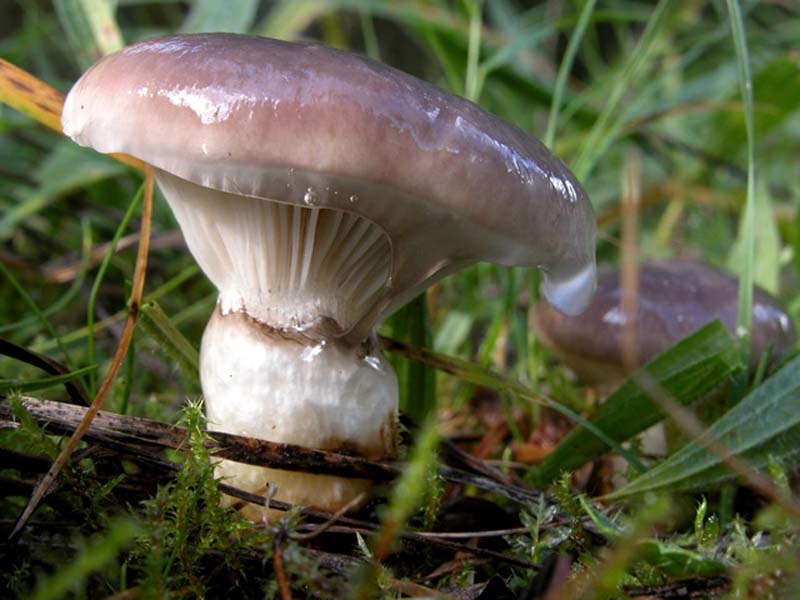
It is also called pine or shiny mokruha. It differs from other representatives of the species by the purple color of the cap with the edges curled up. Grows in pine forests in temperate climates. The eight-centimeter fleshy hat of young mushrooms has a conical shape and seems to be covered with a thin cobweb. The shiny skin is colored purple, and over time becomes light brown or reddish.
The fleshy, fibrous five-centimeter and often twisted leg has a yellow tint, and at the base it is bright orange. On the cut, the flesh becomes pink, and darkens during heat treatment.
Spore plates in young specimens are covered with a film and look pink-purple, with time they acquire a dark shade. They can be easily separated from the hat. When frozen, mushrooms acquire a copper-purple color.
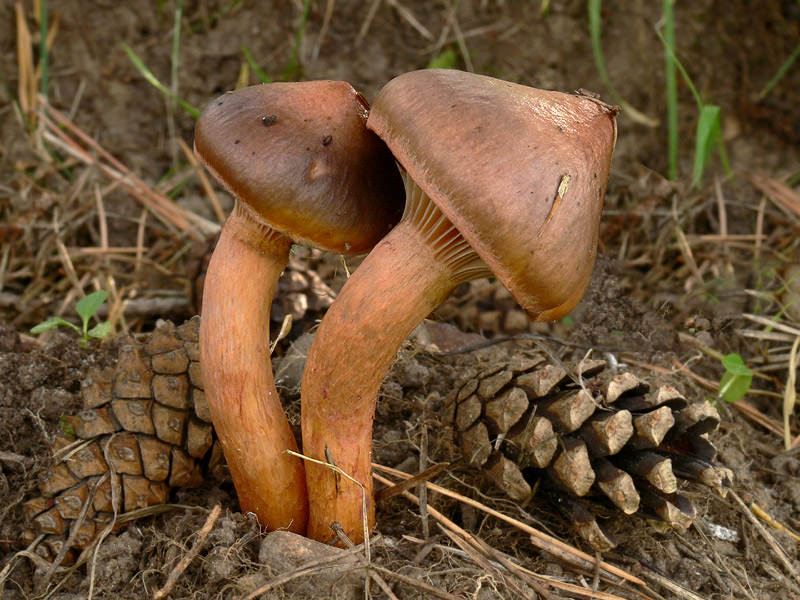
Its second name is mucous. Grows surrounded by spruces and larches. Dark spots clearly stand out on her small hat. When cut, the mushroom turns red. In young specimens, the spore plates are sparse and light, then they darken.
The leg is curved, rather dense, painted off-white with yellow spots. In length, it reaches up to 8 cm. First, it connects to the cap with a thin film, from which only a small mucous ring subsequently remains. Spore plates have an olive tint. Before use, the mushroom requires a long boil.
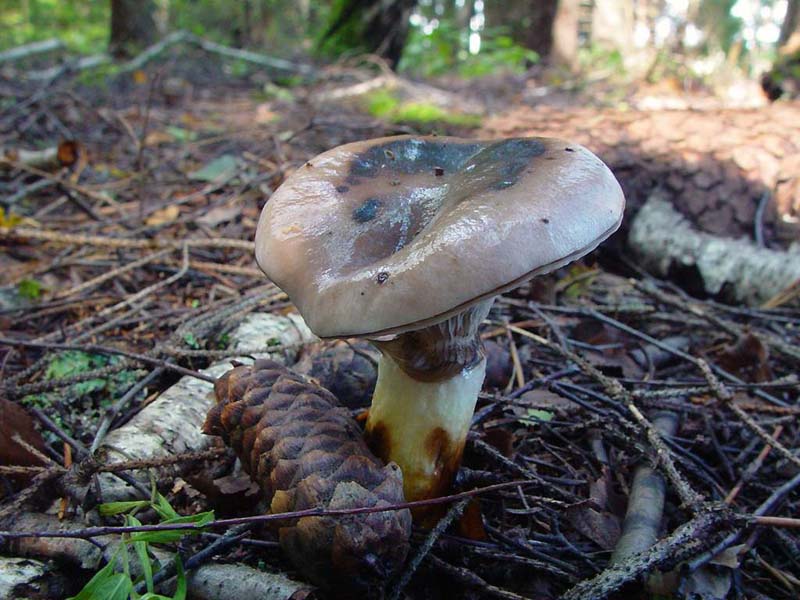
Often, because of the fluff covering the light hat, it is also called fleecy. It is smooth, divided into shallow grooves along the edges. Orange-brown plates descend on the leg. The hat sometimes reaches a diameter of up to 10 cm. The pulp has different shades of ocher color., and when dried, it acquires a brown or pink-wine color.
An even leg with a slight thickening in the middle is painted in the same colors as the hat. Spores are dark brown. The mushroom usually grows in protected forests, next to pines or firs. Massively appears in autumn, often in large groups.
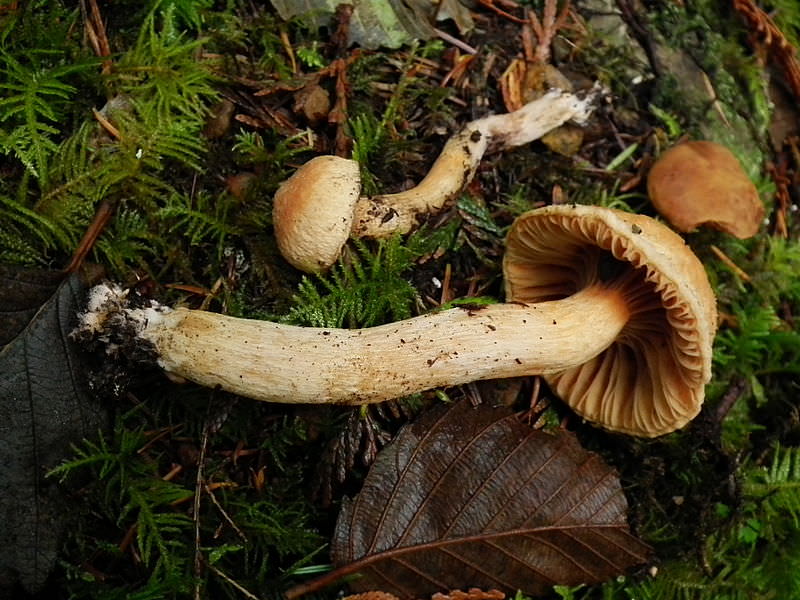
The size of the cap does not exceed 6 cm. At first, it resembles a hemisphere with a lowered edge, and then it opens and turns from purple-pink to bright red. The spore plates are juicy and sparse, going through color stages from white to black.
The six-centimeter leg is white on top and brown on the bottom, it has a ring in the form of a roller. Mushroom flesh is white and dark underneath. Spores are grey. Due to the rare beauty of the combination of a pink cap and dark spore plates, it differs from other agaric mushrooms, with which this mokruha cannot be confused.
Similar mushroom species
Many varieties of mokruha have dark hats, which are similar to goat or common oiler. The latter has a porous olive-yellow layer on the back of the cap. Mokruhi also belong to agaric mushrooms.
It is the presence of rare white plates, which become darker near the stem, that distinguishes these mushrooms from the goats that often grow next to them. In addition, young specimens are provided with a thin mucous layer. And on old mushrooms, only a thin ring remains from it near the cap.
How to recognize mokruhi mushrooms (video)
Primary processing and methods of preparing mokruh
Mokruhi are boiled, fried, marinated, salted and dried. They are used to prepare sauces, soups and casseroles. Mushrooms are often used as a side dish for meat or fish. They are an original ingredient for appetizers or salads.
Important! Before preparing a dish of mushrooms, they must be washed well, cleaned of debris and removed from them with a mucous film in the same way as they do with oils.
It's not hard to cook them. Before this, the mushrooms are boiled for a quarter of an hour. As a result of cooking, the pulp changes color to dark or purple. But this does not change its pleasant and rich mushroom aroma and taste.
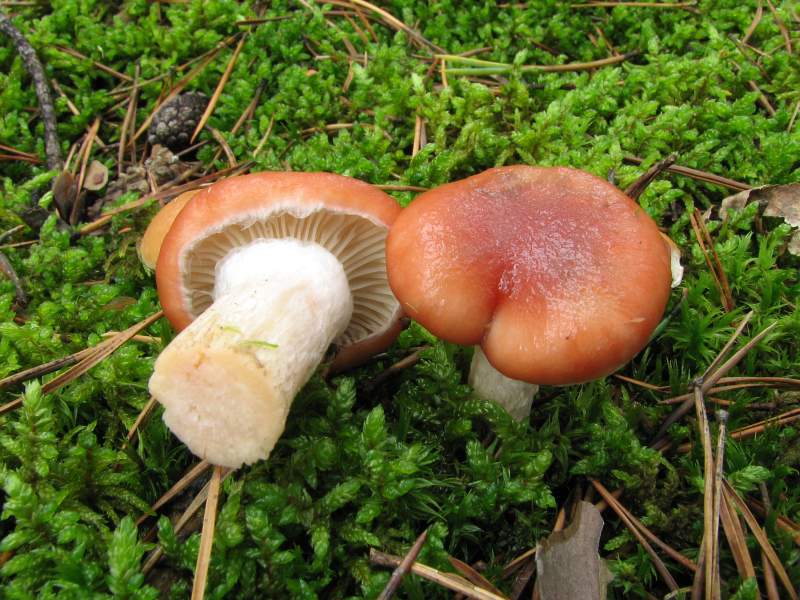
From mokruh, you can cook a casserole according to the following recipe:
- Cut the prepared mushrooms into small pieces, boil in lightly salted water and carefully strain the liquid.
- Peel the potatoes and cut into rings, put in a baking dish.
- Put onion half rings and a layer of mushrooms on it.
- Salt all the ingredients, sprinkle with spices and pour over a small amount of sunflower oil.
- Bake in the oven for at least half an hour.
- Then add a layer of grated cheese.
- Send the casserole dish for a few minutes in the oven to form an appetizing crust on it.
Where spruce mokruha grows (video)
The name of the mushroom "mokruha" does not sound very appetizing, but it is no less useful than porcini, boletus or boletus. Mushrooms contain vitamins B, E and C, they are rich in minerals, fiber. They are useful for chronic fatigue, insomnia, headaches, they can stimulate hematopoiesis, and thanks to the natural antibiotic contained in mushrooms, they have an antiviral effect.




